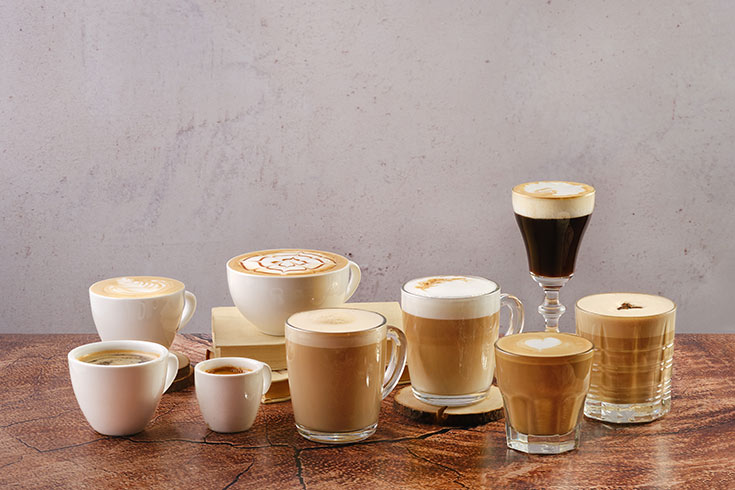Cappuccino vs. Latte: Choosing Your Wake-Up Call
Have you ever walked into a coffeehouse and felt overwhelmed by the choices, especially when deciding between a cappuccino, an iced latte, or even a macchiato? You’re not alone.

The world of coffee can be confusing, especially when terms like “cappuccino” and “latte” are thrown around. But what sets these coffees apart?
Coffee Culture
Coffee is more than just a morning pick-me-up or an afternoon refresher; it’s a global phenomenon. From the streets of Italy, where the debate of cappuccino vs. latte might have originated, to the cozy corners of local cafes in cities worldwide, coffee is a universal language.
In many cultures, coffee is an integral part of daily rituals. In Italy, for instance, mornings begin with a quick espresso, often consumed standing at a local café bar. In Sweden, there’s the tradition of “fika” – a break taken twice a day to enjoy coffee with a sweet treat. And in Ethiopia, where coffee originated, there’s a ceremonial preparation and consumption of the drink.
With coffee being so deeply embedded in various cultures, it’s no wonder there are countless variations and preparation methods.
What Is a Cappuccino?
When comparing a cappuccino to a latte, the cappuccino stands out as a beloved coffee drink known for its rich texture and intense flavor. Its history is traced back to Italy, where it’s named after the Capuchin monks, probably due to the color of their robes that looked like the drink’s hue.
A traditional cappuccino consists of three distinct layers: the bottom layer of bold espresso, a middle layer of hot steamed milk, and a thick top layer of frothy milk foam. This foam acts like an insulator, ensuring the drink remains hot for longer, and provides a velvety mouthfeel that coffee lovers enjoy.
Aerating the milk creates tiny bubbles, giving the foam its creamy texture, which contrasts beautifully with the liquid beneath. While cappuccinos have a distinct layering, another Italian favorite, the macchiato, is known for its marked espresso shot with just a dash of frothy milk.
In many coffeehouses, the cappuccino remains one of the most popular and beloved drinks for its strong espresso flavor.
What Is a Latte?
In the cappuccino vs. latte debate, the term “latte” is derived from the Italian “caffè latte,” which translates to “milk coffee.” It’s a fitting name for a milder and milkier drink than its cappuccino counterpart.
A latte predominantly comprises steamed milk, which gives it a creamier and more diluted taste. The standard composition is one-third espresso, setting the foundational flavor, and two-thirds steamed milk, which mellows the strong flavor of the espresso. It’s then topped with a thin layer of foam, just enough to add a touch of texture without overwhelming the drink.
Because of its milder flavor profile, lattes are often perfect for flavored syrups like vanilla, caramel, or hazelnut. Additionally, the consistency of a latte is ideal for latte art – those beautiful designs you often see on the drink’s surface, made with steamed milk poured over the espresso.
Cappuccino vs. Latte
Texture and Foam
One of the most defining characteristics of any coffee drink is its texture, determined mainly by the foam and the coffee. When you take a sip, the foam is often the first thing your lips touch, setting the tone for the entire experience.
Cappuccinos are renowned for their dense, velvety foam. This foam is achieved by aerating the milk to create a thick layer of tiny bubbles. The result? A creamy texture that is akin to a fluffy pillow – comforting, enveloping, and deeply satisfying. It’s the kind of foam that can hold its shape, nice and thick.
On the other hand, lattes offer a more subtle foam experience. The foam is lighter and airier. It’s like a light blanket – gentle, smooth, and understated. This thin layer of foam complements the creaminess of the steamed milk beneath, ensuring the drink is smooth from start to finish.
Flavor and Strength
The balance between milk and coffee determines the drink’s flavor profile.
Cappuccinos, rooted in the tradition of espresso coffee, offer a robust flavor with equal parts of espresso, steamed milk, and foam. The espresso shines through, making it the drink of choice for those who crave a pronounced coffee taste with a touch of milkiness. If you’re the kind who needs a strong coffee kick to jumpstart your day, the cappuccino is your trusty companion.
Lattes, in contrast, are for those who prefer their coffee on the milder side. The espresso’s intensity is mellowed with more steamed milk, resulting in a creamier, smoother flavor. It’s the kind of drink that feels like a gentle hug – warm, comforting, and soothing. If you’re in the mood for a coffee experience that’s more relaxed and less intense, a latte is the way to go.
Presentation of Cappuccinos and Lattes
The visual appeal of a coffee drink can enhance the overall experience, and baristas often showcase their skills through intricate designs on the drink’s surface.
The steamed milk’s fluidity allows baristas to create intricate designs, from simple hearts and rosettes to complex patterns and even realistic portraits. The next time you order a latte, take a moment to appreciate the artistry before taking your first sip.
Cappuccinos, with their denser foam, present a different challenge. The thick foam doesn’t lend itself easily to detailed designs. However, a skilled barista can still create simple patterns or use cocoa or cinnamon powders to add a decorative touch. While it might not have the detailed artistry of a latte, a cappuccino’s presentation is all about celebrating its rich, velvety texture.
Making Them at Home
Ingredients Needed:
For both drinks, you’ll need freshly brewed espresso and steamed milk. The difference lies in the foam.
Equipment Required:
A good espresso machine with a steam wand is essential. For a perfect foam, consider investing in a milk frother. You can also use a Moka Pot, but you won’t get the rich crema that a machine will provide.
Steps to Perfect Your Brew:
- Brew your espresso.
- Steam the milk. You’ll want more foam for cappuccinos so it froths for longer.
- Pour the espresso into a cup, followed by the milk. Top with foam.
- For lattes, try your hand at some latte art!
When brewing your espresso, aim for a rich crema on top, which enhances the flavor and indicates a well-extracted shot.
An Alternative to Espresso Machines
While the allure of a coffeehouse experience is undeniable, for many coffee lovers, the absence of an espresso machine at home might seem like a barrier to enjoying some of their favorite coffee drinks. However, there’s a versatile and widely accessible tool that can come to the rescue: the French press.
What Is a French Press?
The French press, also known as a press pot or plunger pot, is a method of manual coffee brewing. It’s a cylindrical glass or stainless steel container with a metal or nylon mesh plunger. The brewing process involves steeping coffee grounds in hot water for several minutes and pressing the plunger to separate the grounds from the brewed coffee.
Using a French Press for Cappuccino and Latte
While a French press doesn’t brew espresso per se, it can produce a strong and rich coffee concentrate that can serve as a base for drinks like cappuccinos and lattes.
- Brewing the Base: Use coarsely ground coffee beans and hot water (just off the boil). A good ratio to start with is 1:15, coffee to water. Allow the coffee to steep for 4-5 minutes before pressing the plunger down.
- Mimicking the Milk: While you won’t get the exact texture of steamed milk from an espresso machine, you can heat the milk separately and then froth it using a manual milk frother or even by giving it a vigorous shake in a sealed jar or bottle. Once frothed, you can add it to your French press coffee to mimic the texture and feel of a cappuccino or latte.
- Flavor and Presentation: The resulting drink will differ slightly from a traditional espresso-based beverage but will still offer a rich and satisfying flavor. You can also add syrups or spices to customize your drink further.
There’s always room for experimentation and personalization in the world of coffee. While purists might argue for the authenticity of espresso machines, using a French press can be a delightful way to enjoy similar beverages from the comfort of your home.
Wrapping up Cappuccino vs. Latte
Cappuccino or latte–it’s all about personal preference. Do you crave the rich foaminess of a cappuccino or the smooth creaminess of a latte? Either way, you’re in for a treat. So, next time you’re at a coffee shop or have some time at home, which one will you choose?
This article originally appeared on Pink When.

